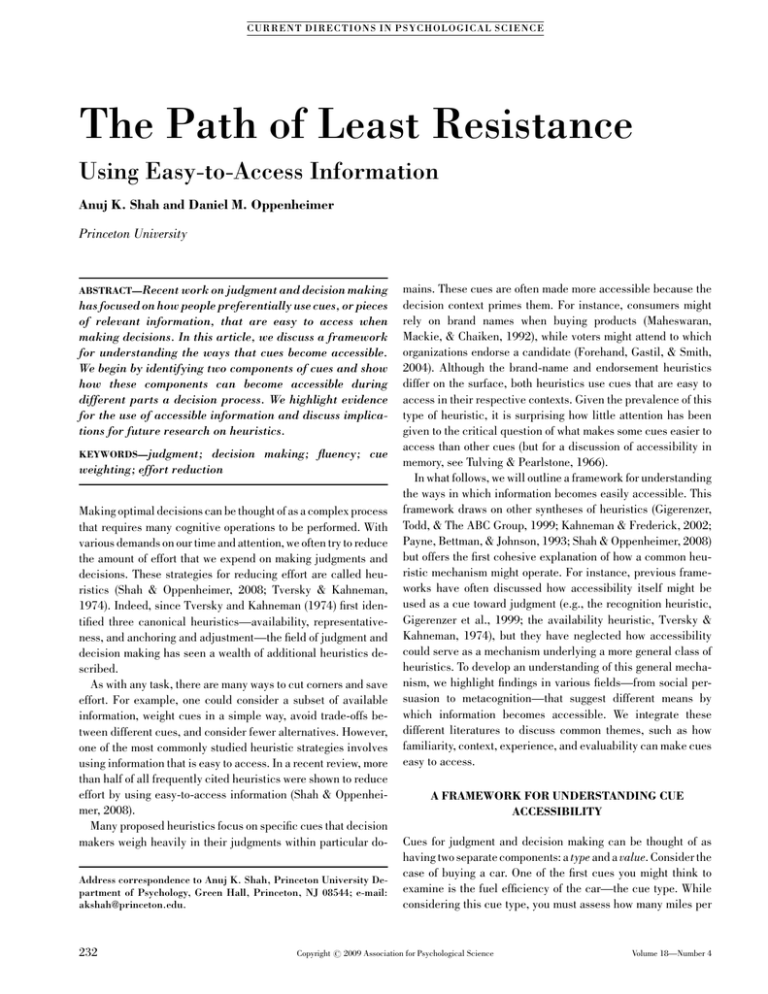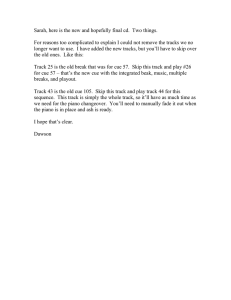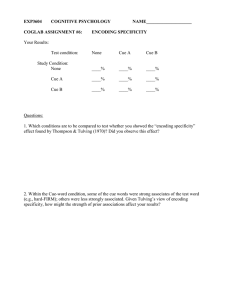(2009). The path of least resistance
advertisement

CURRENT DIRECTIONS IN PSYCHOLOGICAL S CIENCE The Path of Least Resistance Using Easy-to-Access Information Anuj K. Shah and Daniel M. Oppenheimer Princeton University ABSTRACT—Recent work on judgment and decision making has focused on how people preferentially use cues, or pieces of relevant information, that are easy to access when making decisions. In this article, we discuss a framework for understanding the ways that cues become accessible. We begin by identifying two components of cues and show how these components can become accessible during different parts a decision process. We highlight evidence for the use of accessible information and discuss implications for future research on heuristics. KEYWORDS—judgment; decision making; fluency; cue weighting; effort reduction Making optimal decisions can be thought of as a complex process that requires many cognitive operations to be performed. With various demands on our time and attention, we often try to reduce the amount of effort that we expend on making judgments and decisions. These strategies for reducing effort are called heuristics (Shah & Oppenheimer, 2008; Tversky & Kahneman, 1974). Indeed, since Tversky and Kahneman (1974) first identified three canonical heuristics—availability, representativeness, and anchoring and adjustment—the field of judgment and decision making has seen a wealth of additional heuristics described. As with any task, there are many ways to cut corners and save effort. For example, one could consider a subset of available information, weight cues in a simple way, avoid trade-offs between different cues, and consider fewer alternatives. However, one of the most commonly studied heuristic strategies involves using information that is easy to access. In a recent review, more than half of all frequently cited heuristics were shown to reduce effort by using easy-to-access information (Shah & Oppenheimer, 2008). Many proposed heuristics focus on specific cues that decision makers weigh heavily in their judgments within particular doAddress correspondence to Anuj K. Shah, Princeton University Department of Psychology, Green Hall, Princeton, NJ 08544; e-mail: akshah@princeton.edu. 232 mains. These cues are often made more accessible because the decision context primes them. For instance, consumers might rely on brand names when buying products (Maheswaran, Mackie, & Chaiken, 1992), while voters might attend to which organizations endorse a candidate (Forehand, Gastil, & Smith, 2004). Although the brand-name and endorsement heuristics differ on the surface, both heuristics use cues that are easy to access in their respective contexts. Given the prevalence of this type of heuristic, it is surprising how little attention has been given to the critical question of what makes some cues easier to access than other cues (but for a discussion of accessibility in memory, see Tulving & Pearlstone, 1966). In what follows, we will outline a framework for understanding the ways in which information becomes easily accessible. This framework draws on other syntheses of heuristics (Gigerenzer, Todd, & The ABC Group, 1999; Kahneman & Frederick, 2002; Payne, Bettman, & Johnson, 1993; Shah & Oppenheimer, 2008) but offers the first cohesive explanation of how a common heuristic mechanism might operate. For instance, previous frameworks have often discussed how accessibility itself might be used as a cue toward judgment (e.g., the recognition heuristic, Gigerenzer et al., 1999; the availability heuristic, Tversky & Kahneman, 1974), but they have neglected how accessibility could serve as a mechanism underlying a more general class of heuristics. To develop an understanding of this general mechanism, we highlight findings in various fields—from social persuasion to metacognition—that suggest different means by which information becomes accessible. We integrate these different literatures to discuss common themes, such as how familiarity, context, experience, and evaluability can make cues easy to access. A FRAMEWORK FOR UNDERSTANDING CUE ACCESSIBILITY Cues for judgment and decision making can be thought of as having two separate components: a type and a value. Consider the case of buying a car. One of the first cues you might think to examine is the fuel efficiency of the car—the cue type. While considering this cue type, you must assess how many miles per Copyright r 2009 Association for Psychological Science Volume 18—Number 4 Anuj K. Shah and Daniel M. Oppenheimer gallon the car gets—the cue value. The way these components become accessible ultimately depends on when the cue is consulted. We assume that there are two points at which cues might become easier to access: during cue acquisition and during cue evaluation. Cue acquisition can occur in two related but distinct ways: cue perception and cue production. Cue perception refers to when decision makers assimilate information from task environments in which cue types and values are provided. In such environments, decision makers have only to perceive the information that has already been accumulated for them (e.g., in tables that compare and contrast different options). Cue production occurs when cues are not presented to decision makers. Instead, decision makers must retrieve previously seen cues from memory or assess new cues for the first time. Cue evaluation refers to when decision makers decide how to incorporate a particular piece of information into a judgment or decision. We will show that cue types and cue values can independently be made more accessible during each of these phases (see Fig. 1). In total, this framework highlights six ways for cues to become more accessible. In what follows, we will explain these principles further and highlight experimental support for their importance in judgment and decision making. CUE ACQUISITION Decision makers might be provided with cues or otherwise retrieve them from memory or assess them on-line. The distinction between these methods of cue acquisition may seem arbitrary, and indeed there is some overlap. Yet these methods can make cues accessible in different ways, and they are often employed to different degrees depending on factors such as task environment and a decision maker’s expertise (for a discussion of external and memory-based information search, see Mandel & Johnson, 2002). Cue Perception It may seem that explicitly providing decision makers with cue types and values makes all information equally accessible. However, decision environments can still make some cues more fluent, or easier to process, than others. Fluency often increases when information is presented in familiar ways. That is, cues can be processed less effortfully to the extent that they have been seen before or are similar to cues encountered previously. For example, recent work has shown how phonetic fluency, or the ease of pronouncing words, can influence which cue types are Cue Perception Cue Production Cue Type: e.g., Phonetic Fluency Cue Type: e.g., Retrieval Fluency Cue Value: e.g., Perceptual Fluency Cue Acquisition Cue Value: e.g., Automatic Assessment Cue Type e.g., Alignability Cue Value: e.g., Evaluability Cue Evaluation Fig. 1. A schematic representation of the current framework describing cue accessibility. Although the task environment will determine whether cues will be already available (cue perception) or will need to be retrieved from memory or assessed online (cue production), some form of cue acquisition will occur, and cue evaluation will follow. At each stage, the cue type and cue value can become accessible through various mechanisms. Volume 18—Number 4 233 Easily Accessible Cues used for judgments (Shah & Oppenheimer, 2007). In one study, participants were told that they would be investing in Turkish stocks based on recommendations by hypothetical Turkish companies. Participants read conflicting recommendations from firms with fluent and disfluent names. Although all firm names were foreign, some names had phonetic combinations that would be slightly more familiar to English speakers. When making judgments, participants appeared to weight the information from easy-to-pronounce sources more heavily (see Fig. 2). The extent to which participants use cue values has also been shown to depend on perceptual fluency, or the ease with which people can perceive information. For instance, participants who saw a consumer review in a familiar, easy-to-read font weighted that review more heavily than did participants who saw a consumer review in a difficult-to-read (but still legible) font (Shah & Oppenheimer, 2007). Fluency can also increase as a result of priming. This likely occurs because priming raises the expectation of encountering a particular stimulus, thereby increasing the ease with which it is processed. Mandel and Johnson (2002) offer an example of how conceptual priming makes cue types more accessible. Participants were asked to make purchasing decisions based on information presented on Web sites that contained background images associated with different cue types (e.g., images of coins to prime the price of an option). Participants consulted information that was prime-consistent more often, ostensibly because the backgrounds prepared them to process that information more readily. Cue Production Related to conceptual priming in cue perception, contexts often prime cue types that have previously been stored, thereby making these cue types easier to recall (i.e., there is greater retrieval fluency). The retrieval fluency of cues can depend on how strongly associated a cue and a particular judgment are. For instance, audiences often respond enthusiastically to well-phrased speeches with convincing messages. Therefore, repeated observation leads to an association between ‘‘audience response’’ and ‘‘message quality.’’ When we are asked to evaluate a particular speech, this prompt primes the strongly associated audience-response cue. This salient cue is then easily retrieved and subsequently factored into judgment (particularly when the motivation or ability to exert mental effort is low). The persuasion literature describes a host of cues that are associated with message quality and that are easy for people to access when making judgments (Axsom, Yates, & Chaiken, 1987). Given that repeated observations of a cue can lead to such associations, it is not surprising that repeated use of a cue can also increase how easily it is retrieved and how heavily it is weighted in decisions (Day & Bartels, 2005). Contexts can also prime certain cues in ways other than the associative mechanisms outlined above. For example, recent work on construal-level theory (for a review, see Trope, Liberman, & Wakslak, 2007) has suggested that psychological distance (i.e., how temporally, spatially, probabilistically, or socially removed a decision is from one’s current state) affects what type of information decision makers will recruit. Decision makers often construe psychologically distant judgments in terms of high-level characteristics and psychologically proximal judgments in terms of low-level characteristics. High-level construal means thinking in terms of abstract, superordinate, and goal-relevant features, while low-level construal means the opposite. For example, a high-level construal of exercise might be Performance Evaluation 62 60 58 56 54 52 50 48 46 44 Fluent cue Disfluent cue Source of Positive Recommendation Fig. 2. Performance evaluations of stocks as a function of source of positive information. Participants were given one positive and one negative recommendation about a stock. These recommendations came either from a fluently or disfluently named brokerage firm. When the fluently named firm gave the positive recommendation (and the disfluently named firm gave the negative recommendation), participants expected the stock to perform better (on a scale from 1 to 100), relative to when the disfluently named firm gave the positive recommendation. These results highlight how phonetic fluency can affect the accessibility of different cue types during cue perception. From Shah and Oppenheimer (2007), Experiment 3. 234 Volume 18—Number 4 Anuj K. Shah and Daniel M. Oppenheimer ‘‘an activity to maintain fitness.’’ A low-level construal might be ‘‘a behavior like running that elevates the heart-rate and produces sweat.’’ It is germane to the current discussion that psychological distance makes high-level information easier to access. For example, in one study, participants were asked to generate a certain number of either pros or cons for a course of action to take place in the distant or near future. For the distant future, it was easier for participants to generate pros (for reasons beyond the scope of this paper, pros are part of high-level construal); the opposite was true for judgments about the near future (Herzog, Hansen, & Wänke, 2007). Pros were primed not because of mere association but, rather, because the context interacted with mental representations to shift the accessibility of cue types. Cue values can be more accessible during cue production if they stem from natural assessments (Kahneman & Frederick, 2002; Tversky & Kahneman, 1983). Natural assessments are cue values that are calculated as part of routine perceptions and cognitions. These assessments are heavily involved in a process known as attribute substitution, which refers to how easy-toaccess cue types are substituted for difficult-to-access cue types during heuristic processes (Kahneman & Frederick, 2002). Generally, cue values become easier to assess to the extent that such assessment depends on processes that have achieved automaticity. Put simply, as decision makers gain experience in assessing certain cue values, it takes less effort to do so. However, humans may also be uniquely equipped to automatically assess some cue values (e.g., fluency, mood, affect) without needing to first accumulate experience (see Kahneman & Frederick, 2002; Slovic, Finucane, Peters, & MacGregor, 2002). This set of privileged cues is ostensibly small, and the process of acquired automaticity probably underlies most natural assessments. CUE EVALUATION While both cue perception and production may not factor in to every judgment, decision makers will nearly always need to decide on the importance and relevance of cue types and values. The structure of some task environments will make it easier to evaluate certain cues, thereby increasing their accessibility (Hsee, 1996; Zhang & Markman, 2001). Cue types can become more accessible if they are alignable, or common, across many alternatives. For instance, Zhang and Markman (2001) asked participants to consider brands of popcorn that had alignable cue types (e.g., caloric information was provided for all brands) and nonalignable cue types (e.g., only one brand’s sweetness was described). Low-motivation participants were more likely to choose consumer items that could be directly compared to others along particular cue types; high-motivation participants were willing to choose items that appeared superior even if they had cue types that could not be directly compared across options. This pattern of results likely occurs because alignability makes Volume 18—Number 4 cue types more accessible (Zhang & Markman, 2001). Related to this point, cue values also become more accessible when they can be evaluated along a meaningful scale (Hsee, 1996). Thus, providing a relevant standard against which to compare a cue value can make the value easier to interpret and therefore more accessible. While this comparison standard might come from alignable cue types, one can imagine a situation in which a stand-alone cue value or endpoints of a scale instead serve as the comparison standard. Although we have suggested that these six mechanisms are separable, there may be cases in which cues become accessible due to multiple mechanisms. Consider the ways in which cue values are represented. As with computer programming languages, different data types (e.g., Booleans, integers, strings) require different amounts of resources. In decision contexts, cues can become easier to access if their data type is simplified. For example, if you were comparing two cars, you could keep track of the actual numeric differences in horsepower, torque, and other cues, but this would become difficult given the numerous cues and different units for each value. Instead, simply retaining whether one car was better, worse, or equal to the other car on a given attribute simplifies the process (Payne et al., 1993; Shah & Oppenheimer, 2008). That is, stored results of these ordinal comparisons are easier to access and integrate into a decision than raw numeric differences. This simplification strategy could affect all phases discussed above. It may be that simpler data types are easier to access from a table of information. It may be that simpler data types are easier to recall. Or, it may be that they are easier to interpret when deciding which cues to use for judgment. CONCLUDING REMARKS This framework was motivated by the fact that numerous heuristics use easily accessible information. The distinction between cue types and cue values emphasized here offers insight into the wealth of recently proposed heuristics (see Shah & Oppenheimer, 2008). It appears that heuristics using accessible cue types are considerably more common than those using accessible values; the above discussion of cue production might explain why this is so. Given that mere association with a context might make cue types accessible, then the number of heuristics that rely on accessible cue types is limited only by the number of decision contexts studied. However, natural or automatic assessment of cue values might take longer to learn or may even be limited to a particular class of general-purpose cognitive operations. The subtle distinction between cue perception and cue production also suggests that cue accessibility can depend heavily on the task environment. Much work has already examined how heuristics perform across environments (e.g., Payne et al., 1993), and similar questions might be asked of the current framework. For example, there may be differences between the 235 Easily Accessible Cues extent to which decision makers rely on accessible cue types versus cue values across cue perception and production. Moreover, it remains an open question as to which of the phases provides the greatest opportunity for effort reduction. Questions such as these have the potential to spur highly profitable research, for they shed light on the features that make information easy to access and influential in decision making. Recommended Reading Kahneman, D., & Frederick, S. (2002). (See References). New York: Cambridge University Press. Explains when highly accessible information is substituted for less accessible information to answer difficult judgments. Payne, J.W., Bettman, J.R., & Johnson, E.J. (1993). (See References). A thorough study of heuristic components and environments that are suited to various heuristics. Shah, A.K., & Oppenheimer, D.M. (2008). (See References). A framework for understanding how strategies for saving effort underlie numerous heuristics. Acknowledgments—The authors would like to thank Danny Kahneman for insightful discussions relevant to this paper and Jeff Zemla for helpful feedback. The writing of this paper was supported in part by Grant # 0518811 from the National Science Foundation. REFERENCES Axsom, D., Yates, S., & Chaiken, S. (1987). Audience response as a heuristic cue in persuasion. Journal of Personality and Social Psychology, 53, 30–40. Day, S.B., & Bartels, D. (2005). The effects of prior use on preference. In B.G. Bara, L. Barsalou, & M. Bucciarelli (Eds.), Proceedings of the Annual Conference of the Cognitive Science Society, July 21–23 (pp. 553–558). Mahwah, NJ: Erlbaum. Forehand, M., Gastil, J., & Smith, M.A. (2004). Endorsements as voting cues: Heuristic and systematic processing in initiative elections. Journal of Applied Social Psychology, 34, 2215–2233. Gigerenzer, G., Todd, P.M., & the ABC Research Group. (1999). Simple heuristics that make us smart. Oxford: Oxford University Press. 236 Herzog, S.M., Hansen, J., & Wänke, M. (2007). Temporal distance and ease of retrieval. Journal of Experimental Social Psychology, 43, 483–488. Hsee, C.K. (1996). The evaluability hypothesis: An explanation for preference reversals between joint and separate evaluations of alternatives. Organizational Behavior and Human Decision Processes, 67, 247–257. Kahneman, D., & Frederick, S. (2002). Representativeness revisited: Attribute substitution in intuitive judgment. In T. Gilovich, D. Griffin, & D. Kahneman (Eds.), Heuristics and biases: The psychology of intuitive judgment (pp. 49–81). New York: Cambridge University Press. Maheswaran, D., Mackie, D.M., & Chaiken, S. (1992). Brand name as a heuristic cue: The effects of task importance and expectancy confirmation on consumer judgments. Journal of Consumer Psychology, 1, 317–336. Mandel, N., & Johnson, E.J. (2002). When Web pages influence choice: Effects of visual primes on experts and novices. Journal of Consumer Research, 29, 235–245. Payne, J.W., Bettman, J.R., & Johnson, E.J. (1993). The adaptive decision maker. New York: Cambridge University Press. Shah, A.K., & Oppenheimer, D.M. (2007). Easy does it: The role of fluency in cue weighting. Judgment and Decision Making, 2, 371– 379. Shah, A.K., & Oppenheimer, D.M. (2008). Heuristics made easy: An effort-reduction framework. Psychological Bulletin, 134, 207– 222. Slovic, P., Finucane, M., Peters, E., & MacGregor, D.G. (2002). The affect heuristic. In T. Gilovich, D. Griffin, & D. Kahneman (Eds.), Heuristics and biases: The psychology of intuitive judgment (pp. 397–420). New York: Cambridge University Press. Trope, Y., Liberman, N., & Wakslak, C. (2007). Construal levels and psychological distance: Effects on representation, prediction, evaluation, and behavior. Journal of Consumer Psychology, 17, 83–95. Tulving, E., & Pearlstone, Z. (1966). Availability versus accessibility of information in memory for words. Journal of Verbal Learning and Behavior, 5, 381–391. Tversky, A., & Kahneman, D. (1974). Judgment under uncertainty: Heuristics and biases. Science, 185, 1124–1131. Tversky, A., & Kahneman, D. (1983). Extensional versus intuitive reasoning: The conjunction fallacy in probability judgment. Psychological Review, 90, 293–315. Zhang, S., & Markman, A.B. (2001). Processing product unique features: Alignability and involvement in preference construction. Journal of Consumer Psychology, 11, 13–27. Volume 18—Number 4




